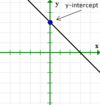2D Geometry Flashcards
(31 cards)
What does “gradient” describe in normal English words?
It describes how steep or slanty a line is.
What is a “coordinate” or “coordinate pair”?
It’s two numbers inside brackets that tell you where a point is.
(x, y)
The first value tells you how far left/right it is from the origin. The second value tells you how far up/down it is from the origin.
What does “y-coordinate” mean?
It’s the second value in a coordinate (x,y).
What does “x-coordinate” mean?
It’s the first value in a coordinate (x,y).
How can we use the gradient to see that two lines are perpendicular?
The gradients of perpendicular lines are the negative reciprocal. For example,

What does “x-intercept” mean?
Where the line crosses the x-axis.

What does y-intercept mean?
Where the line crosses the y-axis.

What is an independent variable?
It’s the variable that influences another.
For example, the grade you get on a test depends on how much you study. Therefore, the amount you study is an independent variable.
What is a dependent variable?
It’s the variable that depends on the other.
For example, the grade you get on a test depends on how much you study. Therefore, your grade is a dependent variable.
On which axis do we put the independent variable?
The horizontal axis. (The x-axis.)
What does “linear” mean when graphing?
It makes a straight line.
What does an equation of a line do? For example, y=x+3?
It tells you about the relationship of x and y. There are infinite x and y points that make a line. This means that for any x you choose, you can use the equation to find what the y must be in order for the point to be on the line.
What is “gradient-intercept” form for a line?
y=mx+c
In the equation y=mx+c, which letter represents the y-intercept?
(Be careful to notice the sign in front of c. This is also part of the y-intercept.)

In the equation y=mx+c, which letter represents the gradient?
(Be very careful not to include “x”. This is only the number BEFORE the x. There is no x in the gradient; it’s just a number.)

What are the two methods to graph the equation Ax+By=C?
- Use algebra to rearrange the formula into gradient-intercept form (y=mx+c).
- Find the intercepts and connect the dots.
- Find the x-intercept by pluggin in y=0 and solving for x.
- Find the y-intercept by plugging in x=0 and solving for y.
What is the equation of a vertical line?
x = ________.

What is the equation of a flat horizontal line?
f(x) = ___________
y = __________

What is the gradient of a flat horizontal line?
0
(Because we go zero steps up, and 0 ÷ anything=0.)

How can we use the gradient to see that two lines are parallel?
Parallel lines have the same gradient.
How do you calculate the gradient?

How do you graph a line of the form y=mx+c?
- Mark the y-intercept (which is c from the equation) on the y-axis.
- Use the gradient (which is m from the equation) to count over to the next point.
- Count up/down
- Count over to the right
How do you find the equation of a line perpendicular to another line?
For example,

- Identify the gradient of the original line. The gradient of the new line is the negative reciprocal of this.
- Find a point that goes on the line (this is usually given).
- Plug the point (x,y) and gradient, m, into the equation y=mx+c and solve for c.
- Write y=mx+c, where m is the slope and c is the y-intercept.
How do you find the equation of a line parallel to another line?
For example, y = 2x + 8?
- Find the gradient of the original line. This is also the gradient of the new line.
- Find a point that goes on the line (this is usually given).
- Plug the point (x,y) and gradient, m, into the equation y=mx+c and solve for c.
- Write y=mx+c, where m is the slope and c is the y-intercept.











